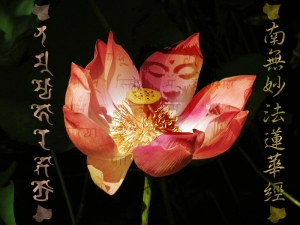
The phrase NAM-MYOHO-RENGE-KYO is taken from the title of the greatest teaching of the first historically recorded Buddha, known as Siddhartha Gautama or Shakyamuni Buddha, who lived in India around 500 years before Christ was born. This teaching, called the Lotus Sutra, declares that all living beings, regardless of gender or intelligence (that means everyone – including you and me!), have the potential to attain Buddhahood. In the Lotus Sutra, Shakyamuni Buddha teaches that inside each one of us a universal truth known as the Buddha nature. Basing our lives on this Buddha nature enables us to enjoy absolute happiness and to act with boundless compassion. Such a state of happiness is called enlightenment. It’s simply waking up to the true nature of life, realising that all things are connected, and that there is such a close relationship between each of us and our surroundings that when we change ourselves, we change the world.

In the 13th Century, a Japanese priest called Nichiren (1222-1282) realised that the message of the Lotus Sutra was summed up by its title, NAM-MYOHO-RENGE-KYO, which can be translated as the teaching of the lotus flower of the wonderful law. Nichiren declared that all of the benefits of the wisdom contained in the Lotus Sutra can be realized by chanting this title NAM-MYOHO-RENGE-KYO. Since the time of Nichiren many, many millions of people have followed his advice, chanting NAM-MYOHO-RENGE-KYO regularly as a means of improving their health, happiness, wisdom and compassion. The goal of chanting NAM-MYOHO-RENGE-KYO is to manifest the enlightenment of the Buddha in our own lives. We can then realise our own creative potential as individuals and, in so doing, create thriving and peaceful families, work places and communities. Eventually this gradual transformation of individuals will create peace and prosperity in societies throughout the world.

Nam
Nam means devotion and respect. So, the whole phrase has the simple meaning of ‘devotion to the Mystic Law of the Lotus Sutra’.
Myoho
Myoho relates to Mystic Law, the essential Universal Law and its manifestations.There are two main relationships: one between life and death, and the other between our most enlightened, or Buddha, state and all our other nine conditions or states of life.
Renge
Renge literally means “lotus flower.” The reason why the lotus is such an important symbol of Buddhism is that it blooms and seeds at the same time. ‘Renge’ signifies the process of cause and effect at work deep within the life of each person.

Kyo
Kyo means sutra or teachings. It is the vibration of our voice which is so important in our Buddhist practice. ‘Kyo’ is the interconnectedness of all phenomena; and how our prayer or the sound of our chanting can affect people and situations out of our immediate sphere. This is why we do not chant in silence.

How do you chant? Don’t worry, it’s simple, really.
Try to find somewhere where you won’t be disturbed for a little while, or have to worry about disturbing others. Sit on an upright chair, facing a blank spot on a wall – so there are no distractions.. Keep your eyes open, and your back as straight as you can – but don’t be uncomfortable. Hold your hands together, so as to keep them still – you may wish to hold them as in prayer – again, don’t be uncomfortable. Set yourself a time for how long you will chant, and stick to it. Remember, it doesn’t really matter whether it’s 2 minutes, 10 or twenty, the point is to set a time and stick to it. Just be determined to keep chanting till the time is up – at first, you might find that this takes quite a lot of determination! Repeat the phrase NAM-MYOHO-RENGE-KYO over and over rythmically, until the time limit you have set is up. For a guide to how to pronounce the words, click here. When you first begin to chant you will probably want to chant quite slowly but this will naturally speed up as you become more familiar with it. If you would like to hear what it sounds like when people are chanting a little faster click here for an audio file.



http://www.guernsey.net/~moorman/Daimoku.mp3

